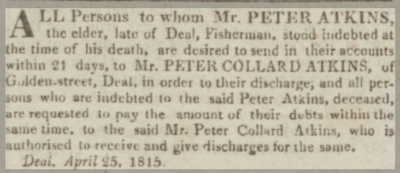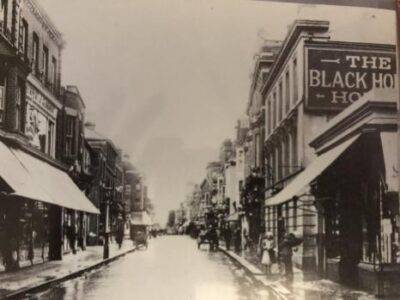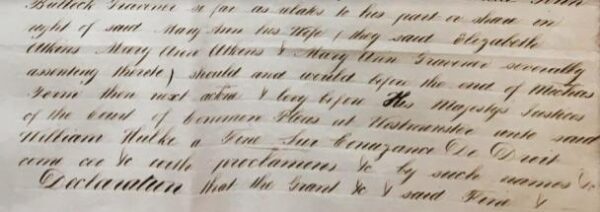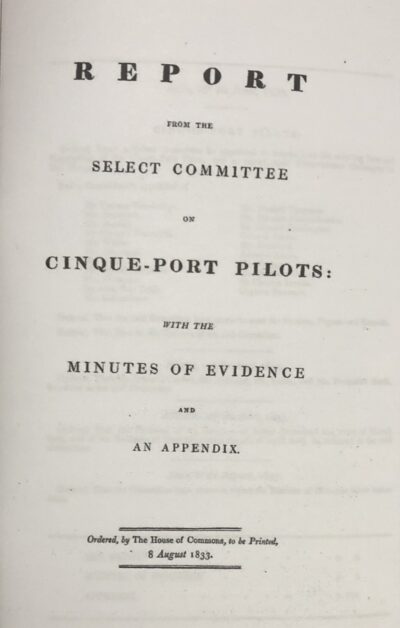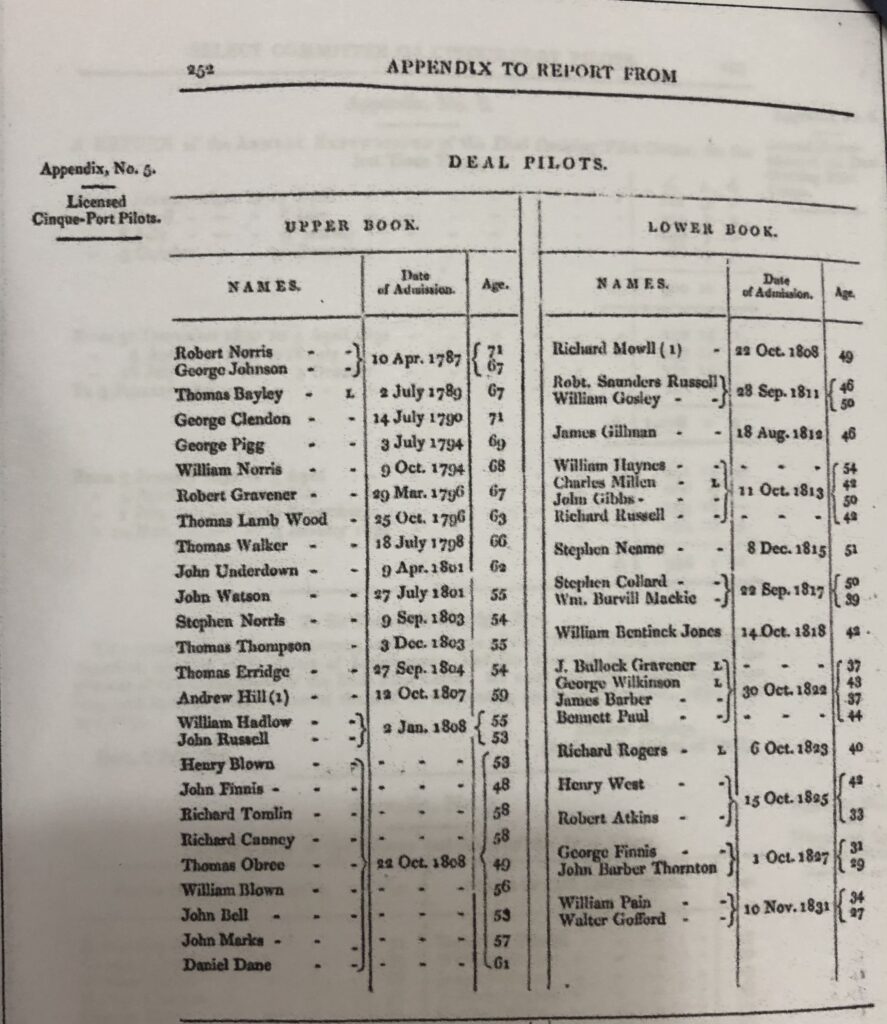Follow us on Facebook @FHofDW
A House In Golden Street
&
The People Who Lived There
Part 2
1782
Peter Atkins “…and his wife Ann…” purchased the freehold of our Golden Street house from the then Lord of the Manor of Chamberlain’s Fee, John Dilnot, in 1782. At this point in time the conveyance, or sale or transfer of property, was made by ‘Lease and Release’.
The ‘Lease’ and the ‘Release’ are separate documents. Unfortunately, in this case, we only have the ’Lease’. Although they were generally joined together, as with many old documents passed down through the years, the two documents have become separated and the ’Release’ is lost.
‘Leases’ are usually fairly short documents a ‘Release’ though can be, as we will see later, long and complicated. Added to which Lawyers in the eighteenth and early nineteenth centuries were paid for writing each line of the document. Therefore the longer and wordier a deed was, the more they got paid!
The process followed for ‘Lease and Release’ was, whereby, an initial ‘leasehold’s interest in a property was sold or conveyed, from one person to another. So for our 1782 document John Dilnot sold the leasehold to “Peter Atkins and Ann his wife ”.
This ‘Lease’ was not an actual ‘Lease’ because the intention was to follow it with a ‘Release’ in order to release the ownership of the freehold and convey the property to the purchaser. The ‘Release’ usually happened the day after the ‘Lease’ was signed. The rental terms of this Lease were usually for 6 months or 1 year and sold for 5 shillings with a payment of one peppercorn per year.
Who was Peter Atkins?
Mariner and fisherman, Peter Atkins married Ann Robinson in St. Leonard’s in October 1767. They had three children, Elizabeth born in 1768, Peter Collard born in 1770 and William who was born in 1777 but sadly he died two years later. Given the gap between Peter and William there may have been other pregnancies for Ann. She died in 1790 and was also buried in St. Nicholas’, Ringwould where the Atkins family originated from.
With many of their family by this time living in Deal who were then later buried in St. Nicholas’, it seems likely that they had purchased a family burial plot.
As the owner of property in 1790 Peter was entitled to vote and, as such, he appears in that year’s Poll Book.
| Freeholder | Freeholds | Of what consisting | Occupier |
|---|---|---|---|
| Peter Atkins | Deal | House | Self and others |
Who the ‘others’ refer to we don’t know, maybe it was other family members or he had taken in lodgers.
In May 1803, after a brief period of peace, Britain was once again at war with France. Feeling threatened by invasion men were raised into a home defence force under the County Lieutenants. Deal’s The Lieutenancy Papers show that Peter was a Sea Fencible. According to The Sea Fencible Indexes of 1805 he was still serving and by then he was a Petty Officer.
We know that Peter was a boat owner, but not the name of his boat, and that in May 1810 he, and his crew, had caught and landed 1200 Mackerel which occasioned a mention in the newspapers.
Peter died in March 1815 and was buried in Ringwould, St. Nicholas’ on 1 April. In his will he left our Golden Street House to his son, Peter Collard Atkins.
Peter Collard Atkins
This Peter was listed as a Mariner and a ‘Housekeeper’ in the Lieutenancy Papers. Being a ‘Housekeeper’ meant you ‘kept’ a house and we found that he owned or at least leased a property in nearby Silver Street, indeed, he was buried from Silver Street in 1817.
The land that the Golden Street house was built on is consistently described as 5 perches and it was on this that Peter Collard built smaller premises, though we don’t know their exact purpose. It was described as a ‘small messuage or tenement and workshop’ the Abstract of Title document dated 1863. We do know that it was in a state of disrepair when the present owners moved in and was finally demolished by them.
Unfortunately, Peter Collard was not to live much longer than his father dying, as we have already said, in 1817. He was buried alongside his wife, who died in 1812, in a Vault owned by her father Richard Claringbold, in St. George’s Chapel Field.
Peter Collard married Caroline Claringbold in 1791 and between them they had seven children with six surviving into adulthood. All these six children were named in their father’s Will, gaining equal shares in his real estate including the Golden Street House. This was all held in trust for them until the youngest, Edward Thomas, reached his twenty first birthday. Peter Collard’s only daughter was also to receive “…all his linen and china, all her mother’s clothes, watch and trinkets, silver pot, sugar basin and cream jug…”
Peter and Sarah Pettet
At this point there does appear to be some missing documents and so, for us, some missing information. This means that it is unclear who was actually living in our house from the time just before Peter Collard’s death in 1817 until around 1824 when we know it was occupied by a Mariner named Peter Pettet who had married Sarah Wellard in that year. A year later their first child, Mary Ann, was born in our house followed by a son, Peter Thomas, in 1827. By the time their last child, Henry Archer, was born in 1830, the Golden Street House had been sold, and they had moved to Middle Street.
The Trust Fund
The trust was funded by the proceeds of Peter Collard’s estate and had been set up to provide for the care and education of his children, the youngest of whom was only nine years old when his father died. It was maintained by the children’s grandmother, Mary Claringbold and their uncle Edward Darby. Both of whom were also executors to Peter Collards Will.
Edward Darby.
Edward Darby had married Jane Claringbold, the younger sister of Caroline. Peter Collard witnessed their marriage in 1808. Jane was to outlive everyone dying in her 103rd year in 1842.
The Children
Presumably the children, until they came of age, lived with their grandmother or some other close relative. The Covenant, or the agreement, in the Abstract of Title dated 1863 and produced for a later sale of our Golden Street House, provides us with some information about them.
In 1826 Mary Ann, the only daughter of Peter Collard and Caroline, married John Bullock Gravener, a Cinque Ports Pilot; in 1822, Peter, the eldest child died in Ireland where he may have been serving in the Preventative Service with his brother Richard. This Peter, in his will, left all he owned to his sister Mary Ann, including his share in the Golden Street House. Richard married Eliza Hogan in Ireland. The remaining children were William Thomas Claringbold, who had married Mary Ann Back in Dover where he was a Cordwainer; John, a mariner who served onboard the H & J Company Yacht and Edward Thomas, a merchant seaman.
1829
The Abstract Title, dated 1863, and our next document, another Lease and Release, all tell us that our Golden Street House was put up for auction at the Black Horse Inn on April 22, 1829, and was purchased by William Hall and his wife Mary.
This ‘Lease’ and the ‘Release’ is over four pages long and both documents start by naming all the parties involved in the sale.
“Edward Darby, Gentleman, Mary Claringbold, Widow of the first part all the surviving children with their spouses of the second part, William Hall and his wife Mary of the third part and William Hulke the younger surgeon of the fourth part”.
The appearance of William Hulke, who is described as a Trustee, in these documents somewhat confused us. The lease states that Edward Darby, Mary Claringbould and the Atkins children their assigns and heirs shall “… to the end and intent that the said William Hulke may by means hereof and by virtue of the statute made for transferring uses into possession be in the actual possession of… the messuages premises hereinbefore bargained and sold …to be … enabled to accept and take a grant and release the reversion and freehold…”
We take this to mean that both William Hulke and the Atkins family had to agree that he was the actual owner of Golden Street and therefore he had the right to sell the house to William and Mary Hall.
To do this meant papers were sent to the Court of Common Pleas at Westminster where a levy, or charge or payment, was made ”… unto said William Hulke a Fine Sur Conuzance De Droit with proclamations …”
But what did this mean and why did this happen?
Well, we found that sur CONUZANCE DE DROIT come ceo. was usually used in cases where a mortgage was involved or to break an entail. Trying to track down something in plain English so we could understand and determine which was the reason in this case, proved difficult.
Why did this happen?We believe that as Peter Collard Atkins devised in his will that “…In the event of any or either of his said children dying unmarried before the youngest was of age and leaving neither wife or child then the property devised to him or her under his will should be divided amongst the survivors share and share alike…”
The fact that Peter Atkins junior died, in 1821, leaving his whole share of his father estate to his sister Mary Ann, when their youngest sibling Edward, was thirteen so still underage, may have had a bearing on this meaning that Mary Ann, her husband and children would benefit more from Peter Collards estate which was not his intention. However Peter Collard’s will itself does not survive, only that extracts mentioned in the Abstract of Title, so no further clues could be gained.
Whatever the reason for this our Golden Street House was purchased by William and Mary Hall on 22 April 1829, at a public auction at the Black Horse Inn in Deal for £80.
A six way split of £80 (approximately £5,424.10 in today’s money) may not amount to much but Peter Collard, as we previously said, leased or owned at least one other property, in Silver Street. He had probably also inherited his father’s boat and more than likely the rights to a capstan ground.
The solicitor acting on behalf of William Hall, for the purchase of our Golden Street house, was one Benjamin Hulke, the brother of the aforementioned William Hulke.
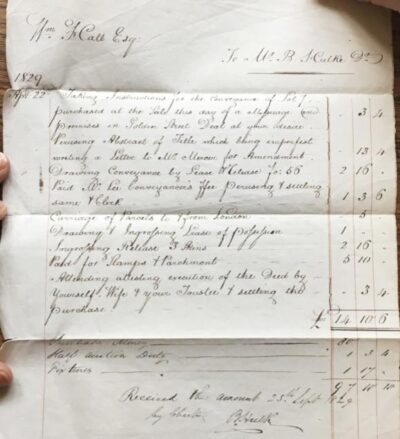 We know this because the bill for his legal fees has survived and was amongst the bundle of documents. The total cost of buying our Golden Street House was £97 10s 10d. We can also see that the person paid for the conveyancing work was a Mr. Lee. He was probably Robert Lee who was a solicitor living in MIddle Street. Mr Mercer, who Mr Hulke sent a letter to amend the Abstract of Title, costing William Hall 13s 4d, was one John Mercer whose practice and home was in Queen Street.
We know this because the bill for his legal fees has survived and was amongst the bundle of documents. The total cost of buying our Golden Street House was £97 10s 10d. We can also see that the person paid for the conveyancing work was a Mr. Lee. He was probably Robert Lee who was a solicitor living in MIddle Street. Mr Mercer, who Mr Hulke sent a letter to amend the Abstract of Title, costing William Hall 13s 4d, was one John Mercer whose practice and home was in Queen Street.
Mary and William Hall
William Hall was a friend, and executor to the will, of Benjamin Dixon who died in Golden Street, in February 1814. In his will Benjamin instructed his executors to sell his estate which included 13 Golden Street whose tenant was then Stephen Norris. This house was conveyed, in July 1814, to Mary East, daughter of Benjamin and Stephen Norris continued to lease it.
In 1778 Mary married John East, their marriage though, wasn’t blessed with any children. John died, in 1815, in Golden Street. So If Stephen Norris was still the tenant of number 13 then they owned or leased another house in the street. Perhaps it was Benjamins or another that they owned or leased themselves.
William Hall and Mary East married in January 1817 when William was a 73 year old bachelor and Mary, a 58 year old widow of two years. It seems that they continued to live in this ‘other’ Golden Street house for the rest of their lives. William died, in Canterbury, a year after they purchased our Golden Street house; he was brought back to Deal and buried in St. George’s on 5 July 1830. When the 1841 census was taken Stephen’s mother, Sarah Norris was living with her sister Mary Hall in her Golden Street home. Mary died here in 1844, leaving a lengthy will and a substantial estate. Her sister Sarah, and her niece Sarah Butler (Sarah’s daughter) were provided for by being given the joint tenancy of the house they all had lived in with the Coach House ground and Stables. Sarah Norris died in this house 1849 aged 93. Mary made many bequests to her nieces and nephews including John East Dixon, Sarah Butler eventually inherited our Golden Street House, with her husband Richard but it was bequeathed to James and Lucy Claringbold for their lifetime. Lucy also received £2,000 for her own use. But who were James and Lucy?
James and Lucy Claringbold
James Claringbold was a carpenter and had married Lucy Dixon, who was the younger sister of Mary Hall, in 1789. They brought up their seven children in Prospect Place, so we assume, following the purchase of our Golden Street House, in 1829, by Mary and William, that they moved into our Golden Street house, soon after, with their adult children. Elizabeth, their spinster daughter, was still living with Lucy in 1851 as were two of her grandchildren, who of course may have just been visiting.
Lucy, it appears, had a bad fall, fracturing her thigh, sometime in 1845. Four years later James died, so having some family members at home must have been more than helpful to her. Lucy died on September 24, 1855, and was buried two days later in St. George’s church yard.
1856
Following Lucy’s death the house was again sold. Richard Butler inherited the house through his wife Sarah, nee Norris, who was Mary Hall’s niece. After Sarah had died in 1856, he sold the house to her brother Stephen Norris though it does seem pretty clear that Stephen never actually lived there.
So who were these two men?
Richard Butler
Richard Butler married Sarah Norris, niece of Mary Hall and sister to Stephen, in 1807. In 1841 they were living with Mary Hall, in the other house in Golden Street. At this time he had ‘independent means’ as an income. In the 1847 poll book, he is listed as a Gentleman but from where Richard gained his financial independence, or where he actually came from, we just don’t know.
Stephen Norris
Stephen Norris however we know more about. As we have already said he was one of the executors of May Hall’s will. He was also one of the trustees to the marriage settlement following the death of her first husband, John East. When Mary married William Hall, in 1817, Stephen was one of their witnesses. All in all, Stephen appears to have been very trustworthy and well thought of.
On November 14, 1801, Stephen married Mary Ann Hare, at St. Mary’s Church, Dover. They then seem to have then set up home at 13 Golden Street, where they had at least 12 children.
Stephen, like Peter Atkins, was also listed as a ‘Sea Fencible’ in the Deal Lieutenancy Papers and he too was still serving in 1805. We know that in 1809 he became a Freeman of Dover enabling him to become a Cinque Ports Pilot.
Then in 1821 William and Mary Hall “… in consideration of the regard which they had for the said Stephen Norris…” conveyed 13 Golden Street to Thomas Pain in trust for Stephen who was still living there.
By 1831 he was a Warden. Wardens were elected from the Pilots of the Upper Book to govern the Cinque Port Pilots and to issue licences to them.
Sadly by this time the Deal & Dover Boatmen and their families were suffering real hardship, some of which was caused by the Pilotage act of 1825. Following an appeal to Trinity House for help, the government ordered a Select Committee Report to be prepared. Stephen, with most of the Boatmen and Pilots of both towns, including John Bullock Gravener, are listed in this report.
As a Pilot he had his own flag. Flags were used to indicate that a vessel was being piloted and by whom. 
The year before Stephen purchased our Golden Street House Mary Ann, his wife, died and he continued to live in their home at number 13.
After purchasing our house Stephen must have leased it out. But, as to whom, is unclear. We do know that in 1861 it was unoccupied and that in 1867 when the sale of the house was announced in the Kentish Gazette the advert stated a Mr Thompson was living there. Then when it was actually sold, a space was left on the copy of the Indenture, that we had access to, followed by the surname ‘Norris’ where the full name of the occupier should be. Perhaps this was Stephen’s nephew, George Fuller Norris as, in November 1867, he and his wife Sarah had their first child, George W Norris, in Golden Street, though soon afterwards they moved to Robert Street. Of course without purchasing a copy of his birth certificate we don’t know at what number George W Norris was actually born in. He may, though, be the last of the Norris family to live in Golden Street certainly by the time the 1871 census was taken there were no Norris’ living there.
1867
In his will Stephen named his eldest son Thomas Dixon Norris and his cousin John East Dixon as his executors. He instructed that they sell all his real estate, which included our Golden Street House. So it was on May 16, 1867, at the Public Auction Rooms in Deal, that John and Maria Day purchased our Golden Street House for just £66.
John and May Day
John Day had been in the 77th East Middlesex Regiment of Infantry, serving in Ireland, Jamaica and North America.He retired as a Colour Sergeant in 1852. We know that he married Maria sometime after 1833 as Maria, then married to a James Silverthorne, had given birth to a daughter, also named Maria, in Jamaica that year. There is no definite death or burial record for James or a subsequent marriage between Maria and John Day, at least, that we can find.
On the 1871 census John is listed as a Pensioner and a ‘Hall Keeper,’the name of the ‘Hall’ is not given. John died in 1872 leaving Maria to earn a living for herself and we know from the 1881 census that she was taking in lodgers. Maybe she was utilising the small dwelling that Peter Collard had built at the rear of the house. We also know that in 1887 Maria borrowed £30 from Charles Pordige, a Trinity Pilot, by way of a mortgage. This money, with the rents paid by her lodgers, must have helped sustain Maria through her widowhood and until the end of her life in 1893 when she was buried in Hamilton Road Cemetery alongside John.
Their small round headstone reads-
In affectionate remembrance of John Day who died 3 March 1872 in the 62nd year of his age.
In sure and certain hope of a Glorious Resurrection to eternal life
through the atoning blood of Jesus Christ
Also Maria wife of the above who died 23 March 1893 aged aged 87 years
Looking into Jesus.
At the time of Maria’s death, she hadn’t cleared the £30 mortgage so when the house was again put up for sale it was in the name of John Kennard, Maria’s executor, and Charles Pordige the mortgagor.
On July 8, 1893, our Golden street House was purchased by Edward Richard Dodd for the sum of £80. Maria’s estate received £50 of this, and Charles Pordige was repaid his £30.


